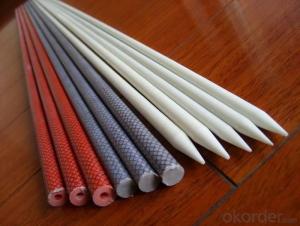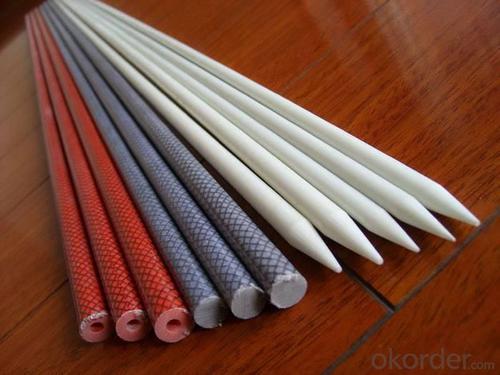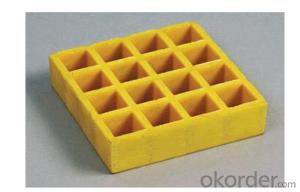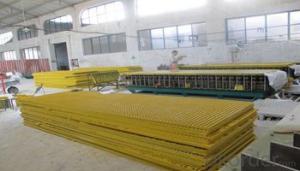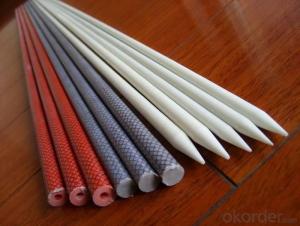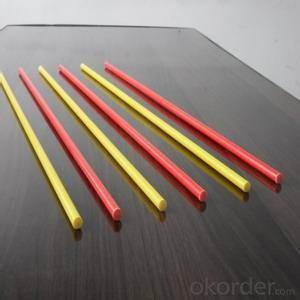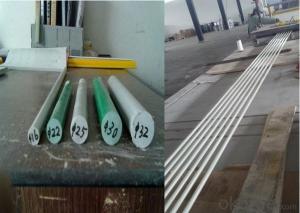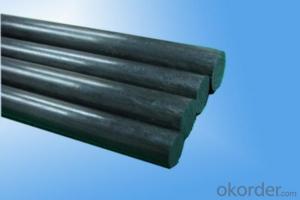FRP Pultrusion Profiles - Excellent Flexible Fiberglass Stake
- Loading Port:
- China Main Port
- Payment Terms:
- TT OR LC
- Min Order Qty:
- -
- Supply Capability:
- -
OKorder Service Pledge
OKorder Financial Service
You Might Also Like
Specifications of Excellent Flexible Fiberglass Stake:
Corrosion resistant
Non-magnetic electromagnetic transparency
Nonconductive
High strength
ISO Certificate
Product Description of Excellent Flexible Fiberglass Stake:
1. diameter from 1mm to 50mm
2. any color available
3. any length
4. quick delivery
Fiberglass rods, FRP rods |
Diameter: 1mm 2mm 3mm 4mm 5mm 6mm 7mm 8mm 9mm 9.5mm 10mm 11mm 12.7mm 14mm15mm 16mm 18mm 19mm 20mm to 50mm |
color: red, black, white, yellow, blue, green, white, gray, any color |
Length: cut according customer requirement |
OEM: available |
High Strength, Corrosion resistance, Chemical resistance, Flexibility, Aging resistance |
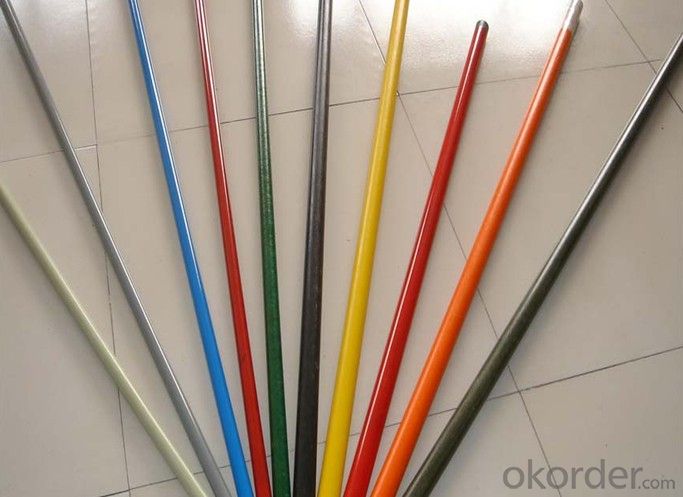
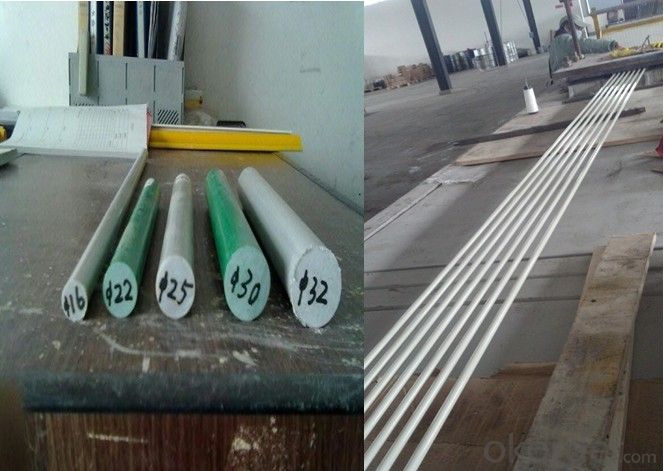
- Q: Are FRP pultrusion profiles resistant to alkaline substances?
- FRP pultrusion profiles are known for their general resistance to alkaline substances. By using fiberglass reinforced polymer (FRP) in pultruded profiles, they acquire excellent resistance against a wide range of chemicals, including alkaline substances. The manufacturing process typically involves using a thermosetting polymer, such as polyester or vinyl ester, as the resin. This choice of resin ensures high resistance to alkaline solutions. Additionally, the fiberglass reinforcement adds strength and durability to the profiles, making them highly resistant to corrosion and degradation caused by alkaline substances. However, it is important to note that the specific resistance of FRP pultrusion profiles to alkaline substances may vary depending on the resin formulation and manufacturing process used. Therefore, it is advisable to consult the manufacturer or supplier to confirm that the profiles meet the specific resistance requirements for alkaline environments.
- Q: Can FRP pultrusion profiles be used in the construction of chemical processing equipment?
- Yes, FRP (Fiber Reinforced Polymer) pultrusion profiles can be used in the construction of chemical processing equipment. FRP pultrusion profiles offer several advantages that make them suitable for such applications. Firstly, FRP pultrusion profiles are highly resistant to corrosion, making them ideal for use in chemical environments where exposure to corrosive substances is common. Unlike traditional materials such as steel, FRP pultrusion profiles do not rust or corrode, ensuring a longer service life and reducing maintenance costs. Secondly, FRP pultrusion profiles are lightweight yet strong, providing excellent structural integrity and load-bearing capacity. This is particularly important in chemical processing equipment, where the materials used must withstand high pressures and temperatures. The strength of FRP pultrusion profiles allows for the construction of robust and durable equipment. Additionally, FRP pultrusion profiles offer design flexibility, allowing for the customization of shapes and sizes to meet specific requirements. This enables the construction of complex chemical processing equipment with intricate designs that are not easily achievable with traditional materials. Furthermore, FRP pultrusion profiles have excellent electrical insulation properties, which can be advantageous in chemical processing equipment where electrical conductivity needs to be minimized to prevent unwanted reactions or hazards. Overall, FRP pultrusion profiles are a reliable and cost-effective choice for the construction of chemical processing equipment. Their corrosion resistance, strength, design flexibility, and electrical insulation properties make them suitable for a wide range of applications in the chemical industry.
- Q: What is the torsional strength of FRP pultrusion profiles?
- Various factors, such as the type and arrangement of fibers, resin matrix, manufacturing process, and overall profile design, determine the torsional strength of FRP pultrusion profiles. Typically, FRP pultrusion profiles are designed to possess a high torsional strength, thanks to the inherent properties of the composite materials utilized. The specific application and desired performance requirements can result in variations in the torsional strength of FRP pultrusion profiles. Manufacturers frequently conduct extensive testing to ascertain the torsional strength of their profiles and provide customers with relevant data. In comparison to conventional materials like steel or aluminum, FRP pultrusion profiles are renowned for their exceptional torsional strength. The combination of high-strength fibers and a robust resin matrix enables FRP profiles to endure substantial torsional forces without experiencing permanent deformation or failure. It is worth noting that the torsional strength of FRP pultrusion profiles can be tailored to meet the precise demands of a project. Manufacturers can optimize the torsional strength by adjusting the fiber type, fiber orientation, resin system, and profile geometry. This ensures that the profiles can withstand the anticipated loads and operational conditions. In conclusion, the torsional strength of FRP pultrusion profiles is typically high due to the unique properties of the composite materials used. Furthermore, it can be further customized to satisfy specific application requirements.
- Q: Can FRP pultrusion profiles be used in pedestrian bridges?
- Yes, FRP pultrusion profiles can be used in pedestrian bridges. FRP pultrusion profiles offer a number of advantages that make them suitable for bridge construction, including their high strength-to-weight ratio, corrosion resistance, and durability. These profiles are made by pulling continuous fibers through a resin bath and then through a heated die, resulting in a strong and lightweight material. The lightweight nature of FRP pultrusion profiles makes them ideal for pedestrian bridges as they can be easily transported and installed. Additionally, their high strength allows them to withstand the load requirements of pedestrian traffic. These profiles also have excellent resistance to corrosion, which is especially important for bridges that are exposed to environmental elements such as rain, humidity, and saltwater. Furthermore, FRP pultrusion profiles are highly durable and require minimal maintenance compared to traditional construction materials like steel or concrete. They are not susceptible to rust or rot, and their non-conductive properties make them safe for use in areas with electrical infrastructure. In summary, FRP pultrusion profiles are a suitable choice for pedestrian bridges due to their lightweight, high strength, corrosion resistance, and durability. These profiles offer a cost-effective and long-lasting solution for bridge construction, ensuring the safety and convenience of pedestrians.
- Q: Can FRP pultrusion profiles be used in the construction of industrial flooring?
- Indeed, the utilization of FRP (Fiber Reinforced Polymer) pultrusion profiles is viable in the construction of industrial flooring. These profiles are comprised of a composite material, combining robust fibers (usually glass or carbon) with a polymer resin. This amalgamation of materials imparts exceptional strength, durability, and resistance to corrosion, rendering FRP profiles highly suitable for industrial flooring applications. The primary benefit of FRP pultrusion profiles lies in their remarkable strength-to-weight ratio. Consequently, they are lighter and more manageable compared to conventional materials like steel or concrete. Moreover, FRP profiles possess non-conductive and non-magnetic properties, offering advantages in specific industrial environments. FRP pultrusion profiles also exhibit high resistance to various chemicals, moisture, and UV radiation, making them an ideal choice for harsh and corrosive settings. Unlike steel, they do not rust or corrode, nor are they affected by moisture or rot like wood. As a result, they ensure long-lasting performance and necessitate minimal maintenance. Additionally, FRP profiles can be customized and manufactured in diverse shapes, sizes, and load-bearing capacities to meet specific industrial flooring requirements. They can be designed to withstand heavy loads, impact, vibration, and other dynamic forces commonly encountered in industrial settings. In conclusion, FRP pultrusion profiles offer numerous advantages that make them well-suited for the construction of industrial flooring. Their high strength, durability, corrosion resistance, and customizable nature make them a dependable and cost-effective choice for industrial flooring applications.
- Q: Can FRP pultrusion profiles be used in the construction of recreational vehicles (RVs)?
- Yes, FRP pultrusion profiles can be used in the construction of recreational vehicles (RVs). These profiles offer several advantages such as high strength-to-weight ratio, resistance to corrosion and rot, and excellent thermal insulation properties. Additionally, FRP pultrusion profiles can be easily molded into complex shapes, making them suitable for various applications within the construction of RVs, including structural components, flooring, walls, and roofs.
- Q: Can FRP pultrusion profiles be used in the construction of swimming pool enclosures?
- Yes, FRP (Fiber Reinforced Polymer) pultrusion profiles can be used in the construction of swimming pool enclosures. FRP pultrusion profiles are known for their high strength-to-weight ratio, corrosion resistance, and durability, making them suitable for outdoor applications like swimming pool enclosures. They are lightweight, easy to install, and have excellent resistance to water, chemicals, and UV radiation, making them an ideal choice for constructing enclosures that can withstand the harsh pool environment. Additionally, FRP pultrusion profiles offer design flexibility, allowing for the creation of various shapes and sizes to meet specific enclosure requirements.
- Q: Are FRP pultrusion profiles resistant to moisture absorption?
- Yes, FRP (Fiber Reinforced Polymer) pultrusion profiles are highly resistant to moisture absorption. This is due to the nature of the material used in their construction, which typically includes a combination of fiberglass and resin. Fiberglass is inherently non-porous and does not absorb moisture, while the resin used in FRP pultrusion profiles is specifically formulated to be moisture-resistant. The pultrusion process used to manufacture FRP profiles also contributes to their moisture resistance. During pultrusion, the fiberglass and resin are pulled through a heated die, which not only ensures thorough impregnation of the fibers with resin but also creates a solid, dense structure. This results in a product that is highly resistant to water penetration and moisture absorption. Furthermore, FRP pultrusion profiles can be further enhanced with the addition of protective coatings or surface treatments, such as gel coats or UV-resistant finishes, which provide an additional barrier against moisture ingress. The moisture resistance of FRP pultrusion profiles makes them an excellent choice for applications where exposure to water or high humidity is expected, such as in marine environments, wastewater treatment plants, or outdoor structures. Their resistance to moisture absorption helps to prevent issues like rot, rust, or degradation commonly associated with other materials like wood or metal. Overall, FRP pultrusion profiles offer a reliable and durable solution that can withstand moisture exposure without compromising their structural integrity or performance.
- Q: Can FRP pultrusion profiles be used in renewable energy projects?
- Yes, FRP (Fiber Reinforced Polymer) pultrusion profiles can certainly be used in renewable energy projects. FRP pultrusion profiles offer a wide range of advantages that make them suitable for various applications within the renewable energy sector. Firstly, FRP pultrusion profiles are lightweight yet strong, making them ideal for use in wind turbine blades. The lightweight nature of FRP materials allows for increased efficiency in wind energy generation by reducing the load on the turbine, thus improving overall performance. Additionally, the high strength-to-weight ratio of FRP profiles ensures durability and longevity, even in harsh environmental conditions. Secondly, FRP pultrusion profiles exhibit excellent corrosion resistance, making them suitable for solar panel mounting structures and other components exposed to moisture and outdoor elements. This corrosion resistance ensures that FRP profiles maintain their structural integrity and performance over an extended period of time, reducing the need for frequent maintenance and replacement. Thirdly, FRP pultrusion profiles can be customized to meet specific project requirements, allowing for flexibility in design and functionality. They can be easily molded into complex shapes and sizes, enabling the creation of innovative and efficient solutions for renewable energy projects. Moreover, FRP materials are non-conductive and have excellent electrical insulation properties, making them suitable for use in electrical enclosures and support structures for renewable energy systems such as solar power plants. In conclusion, FRP pultrusion profiles can be effectively utilized in renewable energy projects due to their lightweight, strong, corrosion-resistant, customizable, and electrically-insulating properties. These characteristics make FRP profiles a reliable and sustainable choice for various applications within the renewable energy sector.
- Q: Can FRP pultrusion profiles be used in the construction of elevated walkways?
- Yes, FRP (Fiber Reinforced Polymer) pultrusion profiles can be used in the construction of elevated walkways. FRP pultrusion profiles are lightweight yet strong, making them an ideal choice for creating durable and long-lasting walkways that can withstand heavy foot traffic. They offer excellent corrosion resistance, making them suitable for outdoor applications where exposure to moisture, chemicals, and UV radiation is a concern. FRP pultrusion profiles also have high strength-to-weight ratios, allowing for easy installation and reducing the structural load on the supporting elements. Moreover, FRP profiles are non-conductive, making them a safer option for walkways in areas where electrical hazards are present. Overall, FRP pultrusion profiles offer numerous advantages that make them well-suited for the construction of elevated walkways.
Send your message to us
FRP Pultrusion Profiles - Excellent Flexible Fiberglass Stake
- Loading Port:
- China Main Port
- Payment Terms:
- TT OR LC
- Min Order Qty:
- -
- Supply Capability:
- -
OKorder Service Pledge
OKorder Financial Service
Similar products
Hot products
Hot Searches
Related keywords
